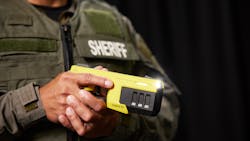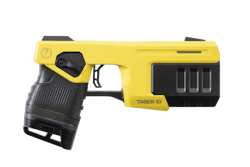TASER 10: New and Improved
Over 20 years ago, while serving as the training commander for a municipal agency just outside Washington, D.C., I was conducting a training course to certify officers in the proper carry and use of the TASER X26. At that point in time, the X26 was the latest, greatest variation of the energy conducting weapon we’ve commonly called “a TASER” for well over 30 years now. At that time, the X26 seemed like a near-science-fiction variation as compared to its predecessor, the TASER M26. With a 60% weight and size reduction from the M26 to the X26, the newer version also increased effectiveness with the (then) new Shaped Pulse electrical waveform that required less power, but was able to create a greater neuro-muscular impact on a subject.
This article appeared in the March/April issue of OFFICER Magazine. Click Here to subscribe to OFFICER Magazine.
Now, in 2023, we see the next evolution of conducted energy weapons, the TASER 10. Before we dive too far into the newest tool, let’s take a look at a few of the criticisms offered about older variants of it.
“The range is too short.” Previous variations had a limited engagement distance of under 25 feet. Given that the TASER is a less-lethal tool that can be chosen to stop potentially lethal attacks, i.e. a knife attack, using proper tactics, 25 feet or less was still considered a bit too close for comfort.
“Shot placement is too critical. It’s too easy to miss a good hit with both probes.” With one shot per cartridge, if you deployed the TASER and missed with one of the two probes, you didn’t get an effective deployment creating the requisite circuit of deployed energy. To take a second shot you had to reload the weapon, under time constraint, and try again.“The red aiming laser can be hard to see during the day, and there’s no way to distinguish it from the lasers on any other tool being used.” The observation was that the industry as a whole (not just AXON) should adopt a policy of green lasers on less- or non-lethal tools and red lasers only on lethal tools. Truth be told, there’s no way the industry members could control that, but the red laser is/was harder to see during daylight hours.
Now let’s jump forward to 2023 and the TASER 10, examining it against the criticisms of previous variants. The first criticism of limited range is neutralized with the new maximum range of the TASER 10: 45 feet. That’s almost double the distance, increasing time to de-escalate a situation, or to engage as necessary to resolve a conflict. Distance equals time and that extra distance is a literal life saver in some instances
The painful (for the officer who fired it) miss, resulting in a mandatory reload has been remedied by engineering a cartridge that permits the officer repeat attempts, up to nine, to get two good contact hits for deployment. The TASER 10 cartridge can deploy individual probes without the need to reload.
And about that red laser… the TASER 10 has a green laser which is far easier to see during daylight hours and just as easy to see as red during hours of low or no light. If your agency is upgrading to the TASER 10, we encourage you to adopt a policy limiting red lasers to lethal weapons and green lasers to non- or less-lethal weapons. Such standardized laser usage can help with visual communication on scene.
For more info, visit: https://www.axon.com/products/taser-10
This article appeared in the March/April issue of OFFICER Magazine.
About the Author
Lt. Frank Borelli (ret), Editorial Director
Editorial Director
Lt. Frank Borelli is the Editorial Director for the Officer Media Group. Frank brings 20+ years of writing and editing experience in addition to 40 years of law enforcement operations, administration and training experience to the team.
Frank has had numerous books published which are available on Amazon.com, BarnesAndNoble.com, and other major retail outlets.
If you have any comments or questions, you can contact him via email at [email protected].


